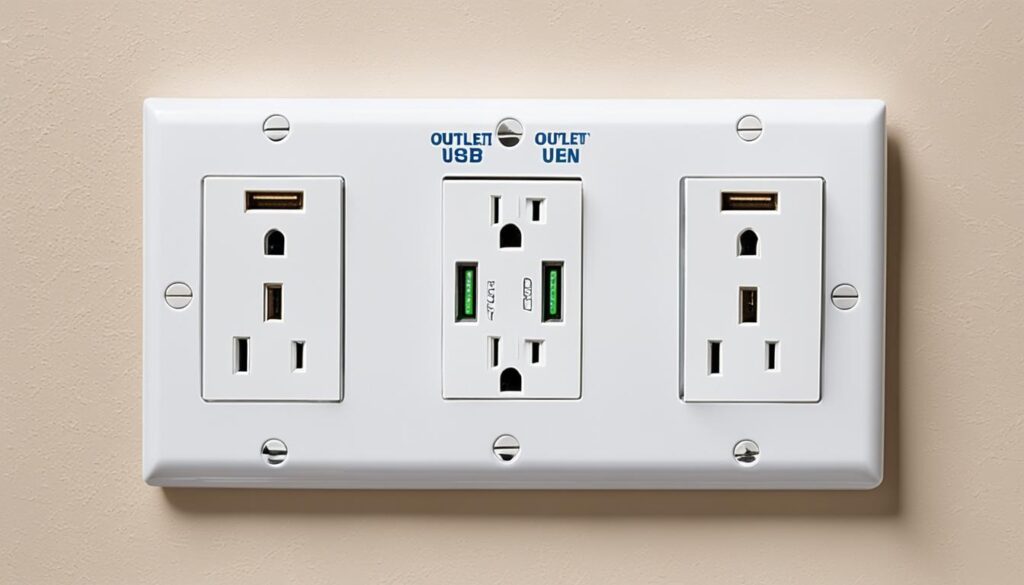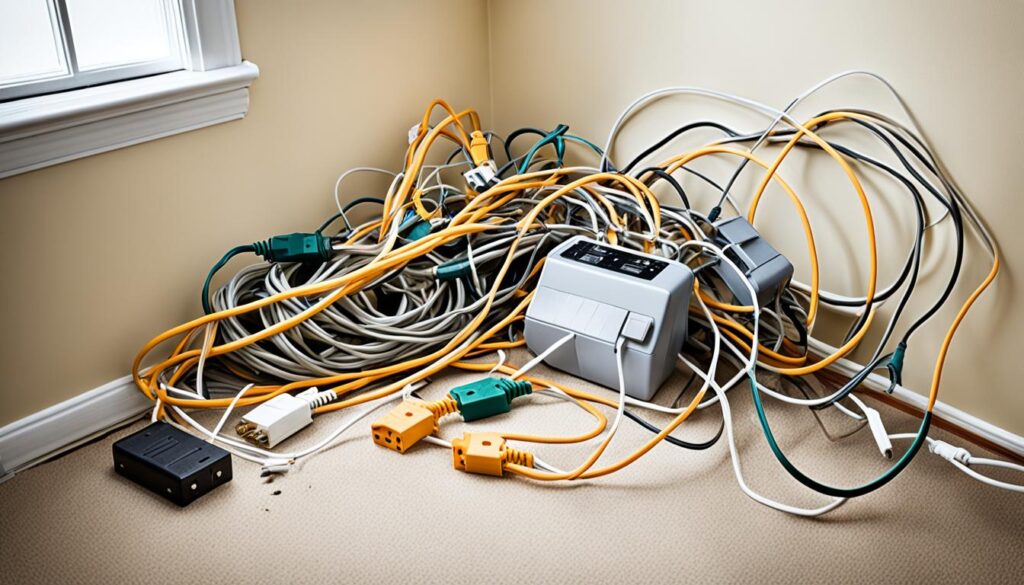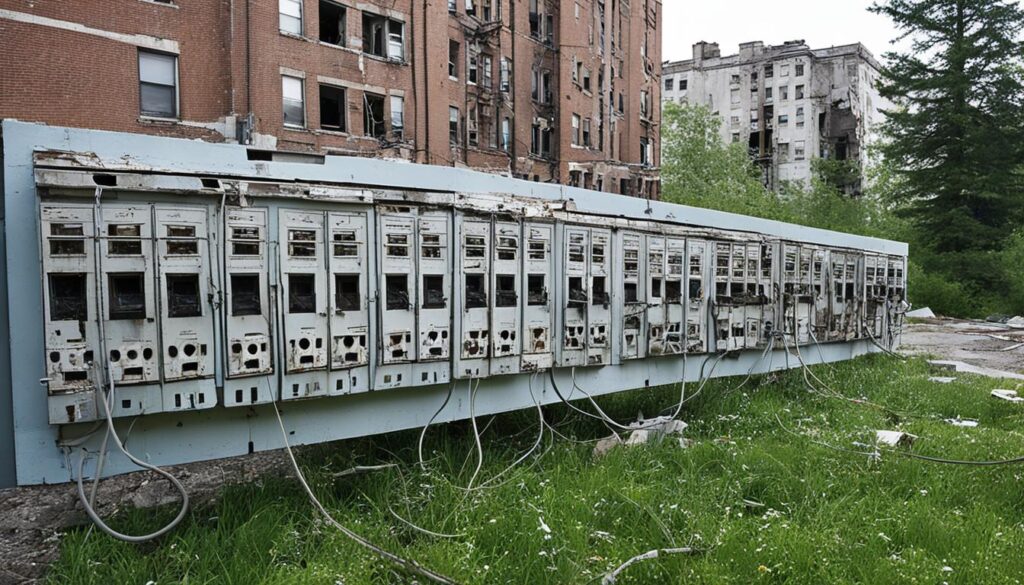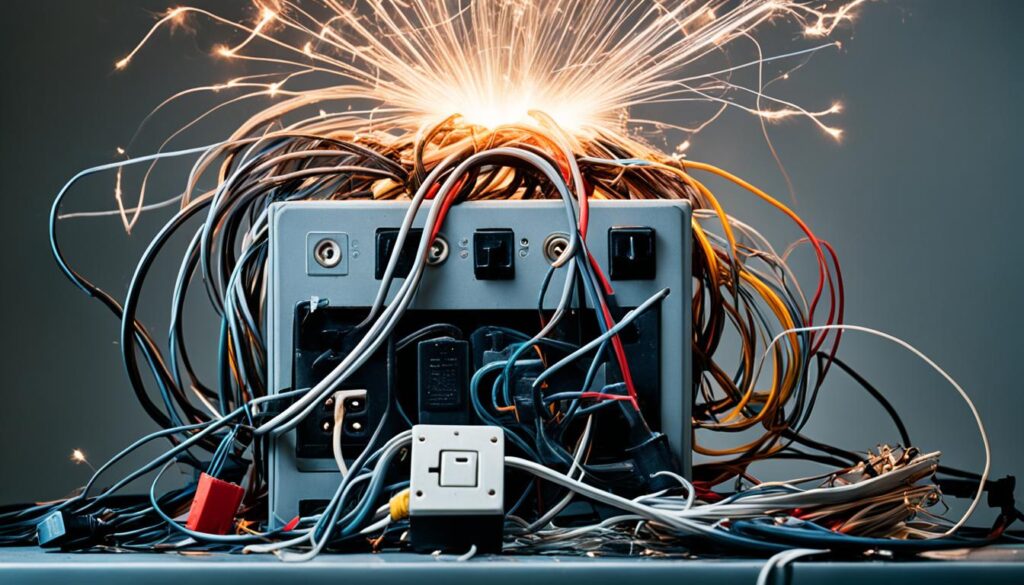Are you tired of struggling with limited power outlets in your home? Overloaded electrical outlets can lead to tripped circuit breakers, increased risk of electrocution, and even fires. But don’t worry, there are safe and effective solutions available to address this issue. Let’s explore some of the options to ensure both convenience and safety in your home.
Key Takeaways:
- Invest in outlet taps for extra receptacles and USB ports.
- Consider using power strips to extend reach and provide additional outlets.
- Choose the right extension cord for bridging the gap between outlets.
- Understand the electrical capacity of older buildings to avoid overloading outlets.
- Take precautions to prevent electrical overload and prioritize safety.
Outlet Taps for Extra Receptacles and USB Ports
Are you tired of running out of outlet space? Outlet taps are a convenient solution that can help you expand the number of receptacles available without the need for extensive electrical work. These devices are designed to plug into existing outlets and provide additional outlets for plugging in appliances and gadgets.
Outlet taps come in various configurations, including three- and six-outlet options, allowing you to choose the one that best suits your needs. Some outlet taps even come equipped with USB ports, making it easier than ever to charge your devices without needing an extra adapter.
One key feature to look for when selecting an outlet tap is surge protection. Power surges can pose a risk to your electronics, causing damage or even permanent destruction. By choosing an outlet tap with built-in surge protection, you can safeguard your devices and enjoy peace of mind knowing that they are protected.

Outlet taps are a versatile and user-friendly solution for expanding the number of outlets in your home. Whether you need extra receptacles for your appliances or USB ports for charging your devices, an outlet tap can provide the convenience and functionality you need.
Extending Reach with Power Strips
If the problem is that the wall outlets are out of reach or there is a need for additional receptacles, power strips can be a suitable solution. Power strips come in different shapes and sizes, with cord lengths ranging from 2 feet to 25 feet. They provide multiple outlets that allow you to plug in several devices at once, making them ideal for offices, entertainment centers, and home offices.
When choosing a power strip, consider the cord length that best suits your needs. Longer cords provide flexibility in placement and allow you to reach outlets that are farther away. On the other hand, shorter cords are ideal for minimizing clutter and keeping your setup organized.
However, it is important to follow safety precautions when using power strips. Power strips should not be covered by flammable materials as they can pose a fire hazard. It is also important to avoid wedging them behind furniture without proper airflow, as this can cause overheating. Additionally, daisy-chaining power strips together or connecting them to extension cords should be avoided, as it increases the risk of electrical overload.
Keeping the area around power strips clean and free of dust is crucial for preventing fire hazards. Dust can accumulate on the plugs and in the sockets, increasing the risk of a short circuit or electrical arcing. Regularly inspecting your power strips for any signs of damage, such as frayed cords or loose plugs, is also important for maintaining safety.
Remember to check the power strip’s electrical capacity and ensure that the total wattage of the devices plugged into it does not exceed its limit. Overloading a power strip can lead to overheating and potentially result in a fire. It is always recommended to consult the manufacturer’s instructions or seek professional advice if you are unsure about the power strip’s capabilities.
Key Points:
- Power strips provide additional outlets for devices that are out of reach or when additional receptacles are needed.
- Consider the cord length of the power strip to ensure it suits your placement needs.
- Follow safety precautions to prevent fire hazards, such as avoiding covering power strips and keeping the area clean and free of dust.
- Avoid daisy-chaining power strips or connecting them to extension cords to prevent electrical overload.
- Regularly inspect power strips for any signs of damage.
- Check the power strip’s electrical capacity to ensure it is not overloaded.
Using Extension Cords for Distance
When an outlet is not within reach, extension cords can be a practical solution to bridge the gap. Whether you need to power a lamp in a dark corner or run a power tool in your garage, an extension cord provides the necessary flexibility. However, it’s important to choose the right type of extension cord to ensure safety and optimal performance.
Indoor extension cords are specifically designed for use inside homes and buildings. They are constructed with materials that are resistant to wear and tear and can handle the demands of everyday appliances and electronics. Make sure to check the label or packaging to ensure that the extension cord is suitable for indoor use.
One important consideration when choosing an extension cord is its electrical capacity. The capacity of an extension cord is determined by the gauge of its wires, which is represented by a number. The lower the gauge number, the thicker the wires and the higher the capacity. For most household applications, a 14-gauge or 16-gauge extension cord can handle up to 13 amps of current.
To determine the maximum wattage that an extension cord can handle, you can use the formula: watts = volts x amps. This calculation helps you understand the electrical capacity of the cord and ensure that it can safely power your devices without overheating or causing damage.
When using extension cords, it’s important to follow some safety precautions:
- Avoid running extension cords under rugs: Placing extension cords under rugs can create a tripping hazard and increase the risk of damage to the cord.
- Replace old cords with signs of wear: If you notice frayed or damaged insulation on the extension cord, it’s essential to replace it to avoid potential electric shocks or fires.
- Avoid using extension cords with heat-producing appliances: Extension cords are not designed to handle the high wattage and continuous use of heat-generating appliances like space heaters. It’s best to plug these appliances directly into a wall outlet to ensure safety.

By choosing the right extension cord and following safety guidelines, you can safely extend the reach of your power source to where it’s needed most.
Understanding Electrical Capacity and Outlets in Older Buildings
In older buildings, especially apartments, it is not uncommon to find a limited number of outlets due to outdated wiring. This can be inconvenient and pose challenges when it comes to powering modern devices and appliances. To navigate this issue effectively, it is essential to understand the electrical capacity of each circuit and the type of outlets available.
The Importance of Electrical Capacity
The electrical capacity of a circuit is determined by its ability to handle the flow of electricity. It is measured in volts (V), amps (A), and watts (W). Understanding these measurements can help you avoid overloading the outlets and ensure the safe operation of your electrical devices.
Amps, also known as amperes, is the measure of electric current. Most circuits in older buildings have a standard capacity of either 15 or 20 amps. To prevent overloading, it is crucial to not exceed the recommended amp rating of the circuit by plugging in devices that draw more current than the circuit can handle.
Grounded outlets, commonly referred to as three-prong outlets, offer an extra layer of safety. The third prong, called the grounding pin, allows excess electricity to be directed into the ground, reducing the risk of electrical shock. If your older building has ungrounded outlets with only two prongs, it is advisable to consult an electrician for options to upgrade to grounded outlets.
Here is an example showcasing the difference between grounded and ungrounded outlets:
| Type of Outlet | Features |
|---|---|
| Grounded Outlets (Three-Prong) |
|
| Ungrounded Outlets (Two-Prong) |
|
In older buildings, it is important to be mindful of the electrical capacity of circuits and outlets to avoid electrical overload. Overloading outlets can result in tripped circuit breakers, damaged appliances, and even fire hazards.

Avoiding Overload and Ensuring Safety
To prevent electrical overload, it is crucial to calculate the wattage of appliances and electronics and ensure they do not exceed the capacity of circuits and outlets. By adding up the wattage of each item used simultaneously, you can avoid overloading circuits, reducing the risk of tripped circuits and electrical issues.
It is also important to practice good habits such as turning off and unplugging appliances when they are not in use. Besides reducing energy consumption, this practice helps to free up outlets and minimizes the risk of accidental activation.
Be vigilant for signs of electrical overload, such as flickering or dimming lights, frequent tripping of circuit breakers, or discolored or warm outlets. These symptoms indicate that the demand on the circuit is too high, and immediate action should be taken to rectify the situation.

Conclusion
In conclusion, there are several safe and effective power outlet solutions to address limited outlets in your home. By following proper safety precautions and understanding the electrical capacity of your circuits and outlets, you can ensure a sufficient and secure power supply.
One important safety precaution is to directly plug in heat-generating appliances like hair dryers and space heaters into electrical outlets, rather than relying on power strips or extension cords. These temporary solutions should be avoided for long-term use.
Outlet taps, power strips, and extension cords can provide additional receptacles and reach when needed. However, it is crucial to use them correctly by considering the wattage and capacity of your electrical system. Overloading a circuit can lead to electrical issues and potential hazards.
If you live in an older building with limited outlets, upgrading the electrical system is the best long-term solution. This will not only provide you with a sufficient number of outlets but also ensure safety by installing grounded outlets and preventing electrical overload.

